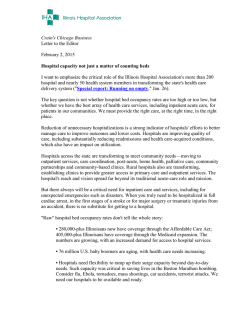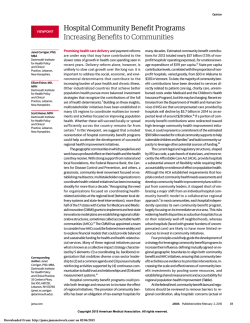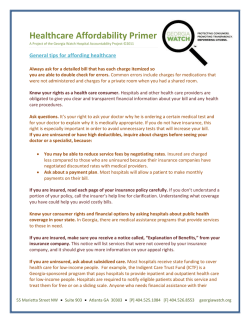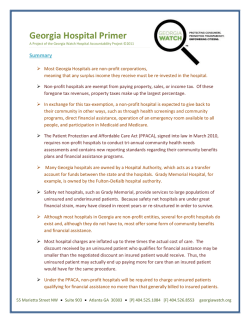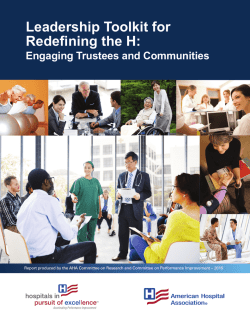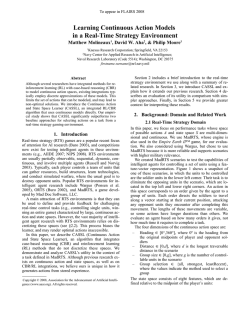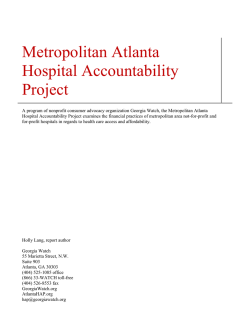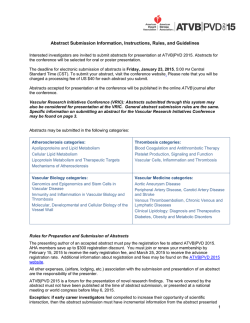
Read more... - Health Services Research
EMBARGOED FOR RELEASE AT: Midnight ET, Thursday, January 29, 2015 CONTACT: Robin Campbell, (312) 422-2075, [email protected] Community Factors Substantially Influence Hospital Readmission Rates CHICAGO – A hospital’s ability to reduce repeat patient visits may have less to do with its performance and more to do with the characteristics of the community where it’s located revealed a new study in the February issue of Health Services Research. The findings may call into question the effectiveness of some federal penalties for hospitals with higher-than-expected readmission rates. The article, “Community Factors and Hospital Readmission Rates,” suggests 58 percent of national variation in hospital readmission rates during those years was explained by the specific county in which the hospital was located. Local factors, particularly the supply of general practitioners, but also income and employment levels and nursing home quality, explain nearly half of the county effect on readmission rates, the study finds. The study looked at 4,073 hospitals in 2,254 counties publicly reported 30-day readmission rates for patients discharged with acute myocardial infarction, heart failure or pneumonia from 2007-2010. “This is one of the most thorough looks, to date, at how hospital readmission rates are explained by community-level factors,” said study lead author Jeph Herrin, Ph.D., a researcher at the Health Research & Educational Trust (HRET), an affiliate of the American Hospital Association. “There has been little examination of how such community factors might influence the readmission rates of hospitals in those communities.” Recently, The Centers for Medicare and Medicaid Services implemented the Hospital Readmission Reduction Program with the intent of levying penalties for hospitals with higher-than-expected readmission rates for Medicare patients. In response to the study, Teryl Nuckols, M.D., director of General Internal Medicine at Cedars-Sinai Medical Center in Los Angeles, suggested these penalties may be ineffective. Some hospitals may be experiencing higher-than-expected readmission rates for reasons beyond their control, Nuckols said in a commentary submitted to HSR. “[It] starts to raise questions about whether hospitals in socioeconomically disadvantaged and underserved communities may have little control over readmission rates, yet be disproportionately penalized by the policy,” Nuckols said. One of the strongest correlations to readmission rates, according to the study, is a community’s access to primary care and high-quality nursing home care. “A substantial amount of the variation in readmission rates is explained by local health-system characteristics related to primary care access and the quality of nursing homes,” Herrin, et al. wrote. “These findings have significant implications on how health care leaders, payers and policy makers should conceptualize the level of accountability for excess readmissions.” For advanced copies of the article and commentary, or for access to the authors, please contact HSR Managing Editor Robin Campbell at [email protected] or by phone at (312) 422-2075. Health Services Research (HSR) is rated as one of the top journals in the fields of health policy and health care sciences and services, publishing the findings of original investigations that expand understanding of the wide-ranging field of health care and help improve the health of individuals and communities. The flagship publication of the Health Research & Educational Trust, HSR publishes six issues a year plus two special supplements. Now in its 50th volume, HSR strives to be the preferred forum for health services researchers, managers, policymakers, providers and students to enhance the knowledge and understanding of financing, organization, delivery and outcomes of health services. For more information about HSR, visit www.hsr.org. Founded in 1944, the Health Research & Educational Trust (HRET) is a private, not-for-profit organization involved in research, education, and demonstration programs addressing health management and policy issues. An affiliate of the American Hospital Association (AHA), HRET collaborates with health care, government, academic, business, and community organizations across the United States to conduct research and disseminate findings that shape the future of health care. For more information about HRET, visit www.hret.org. ###
© Copyright 2024
